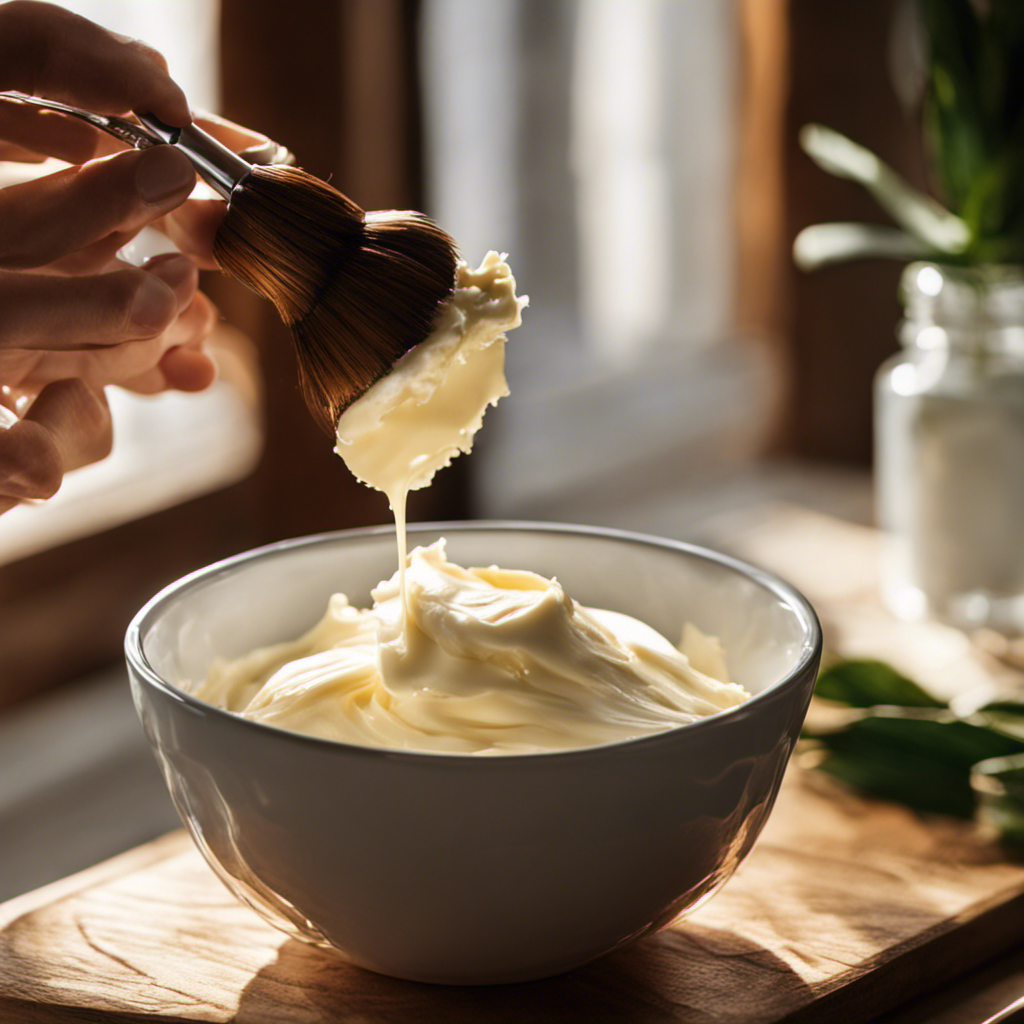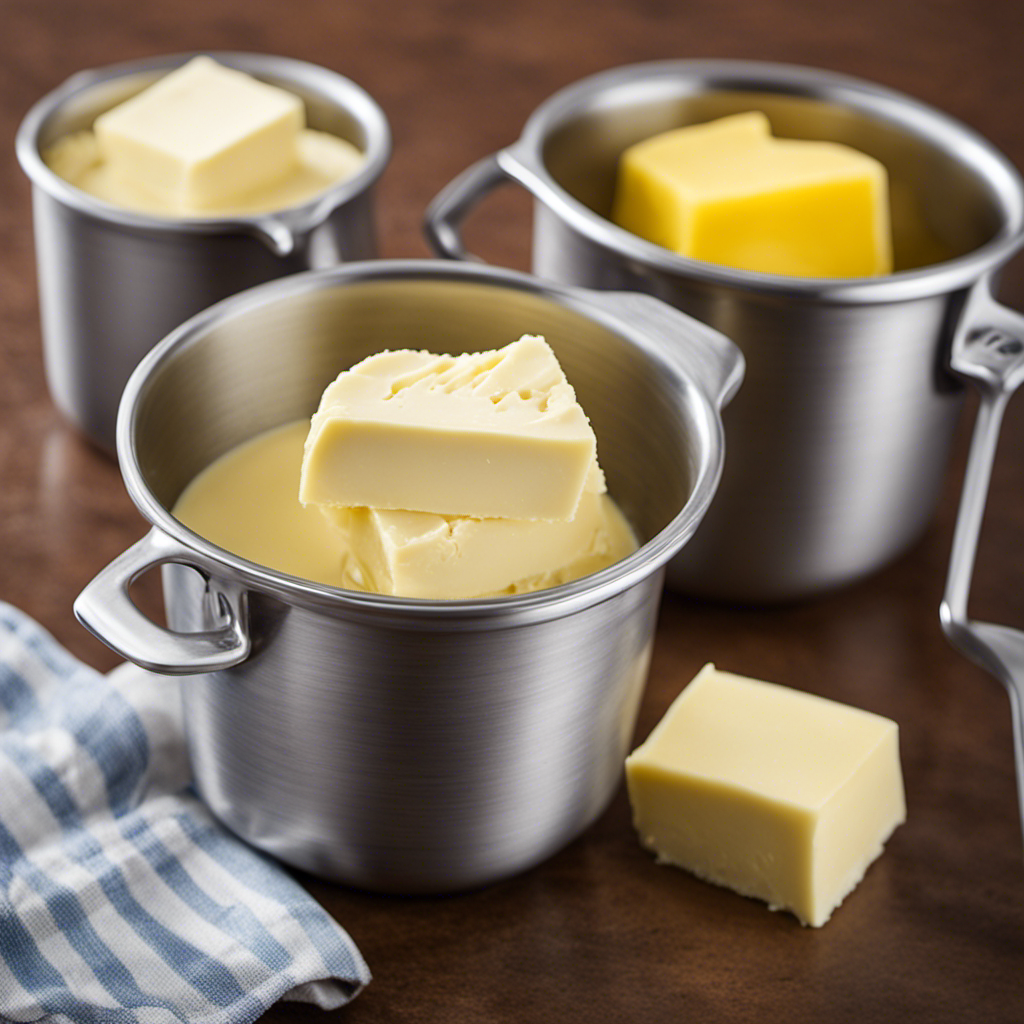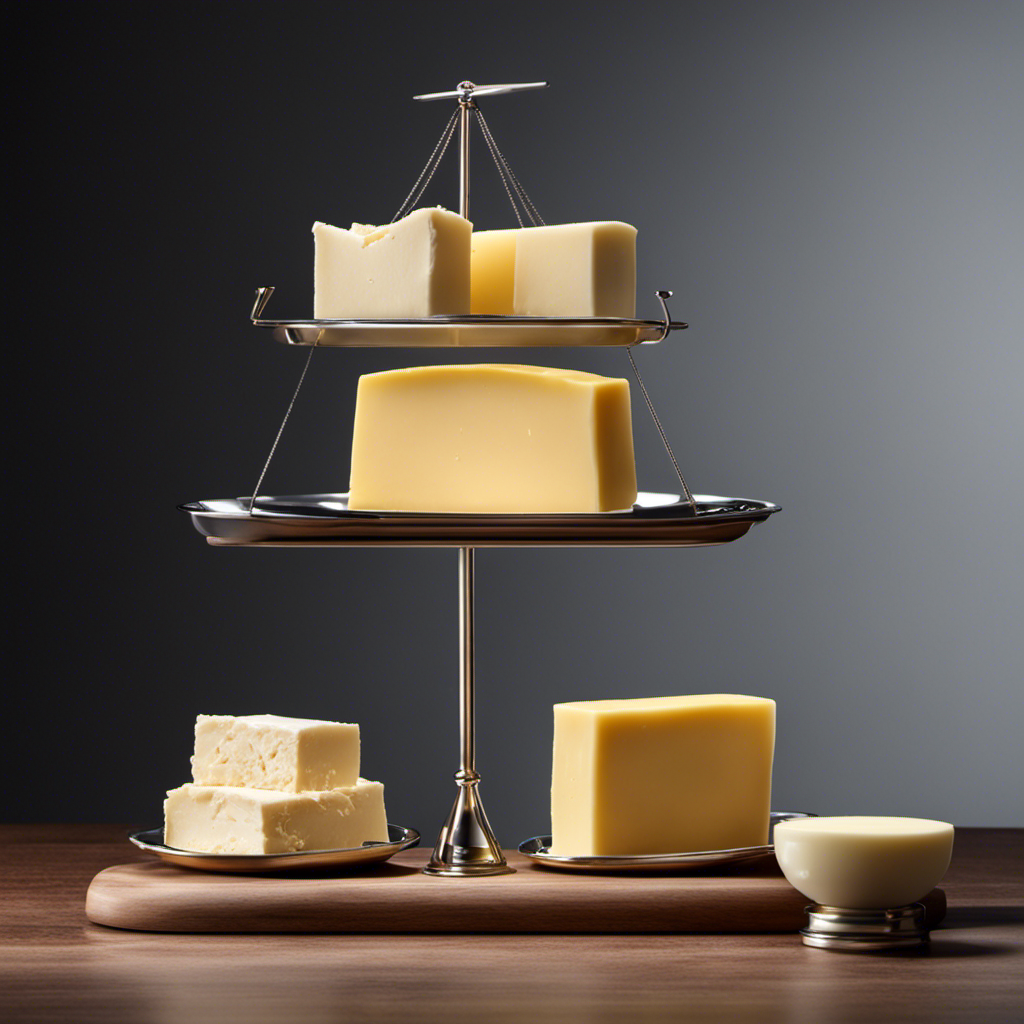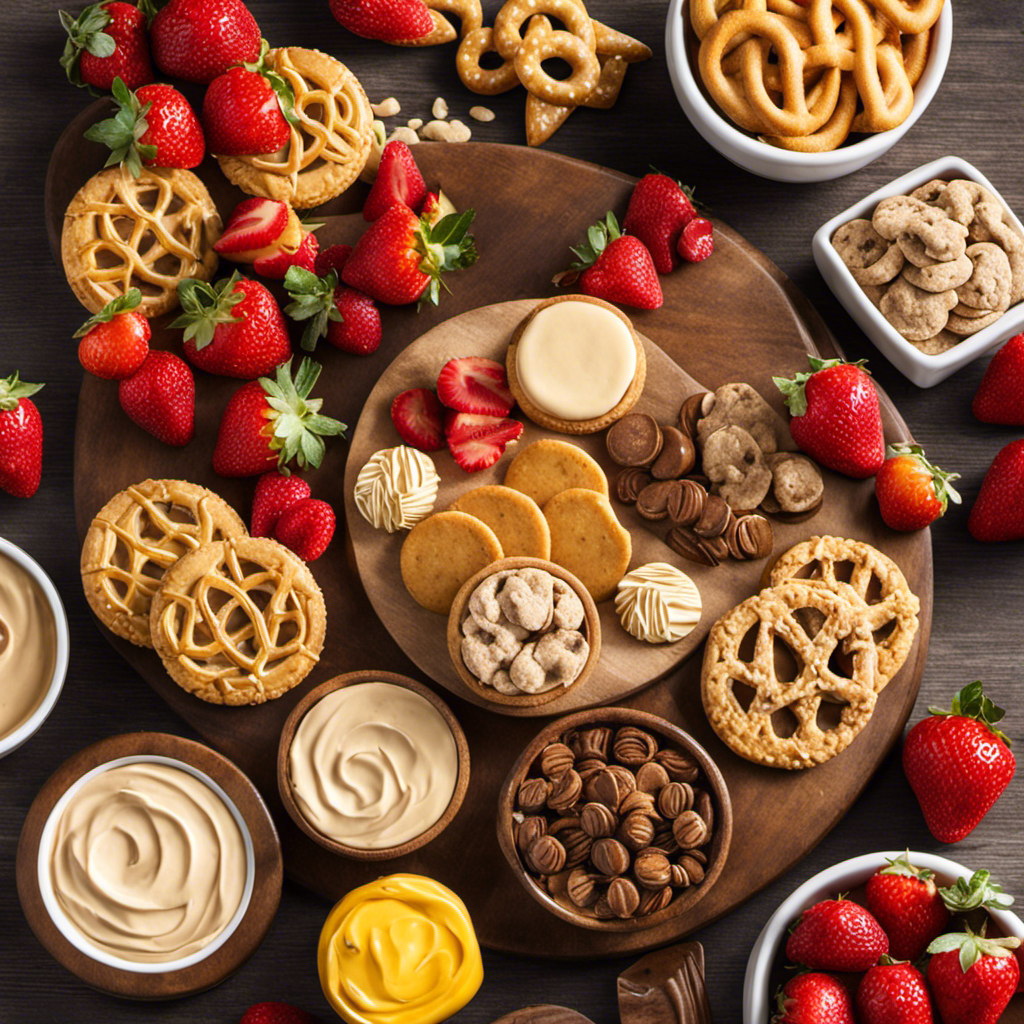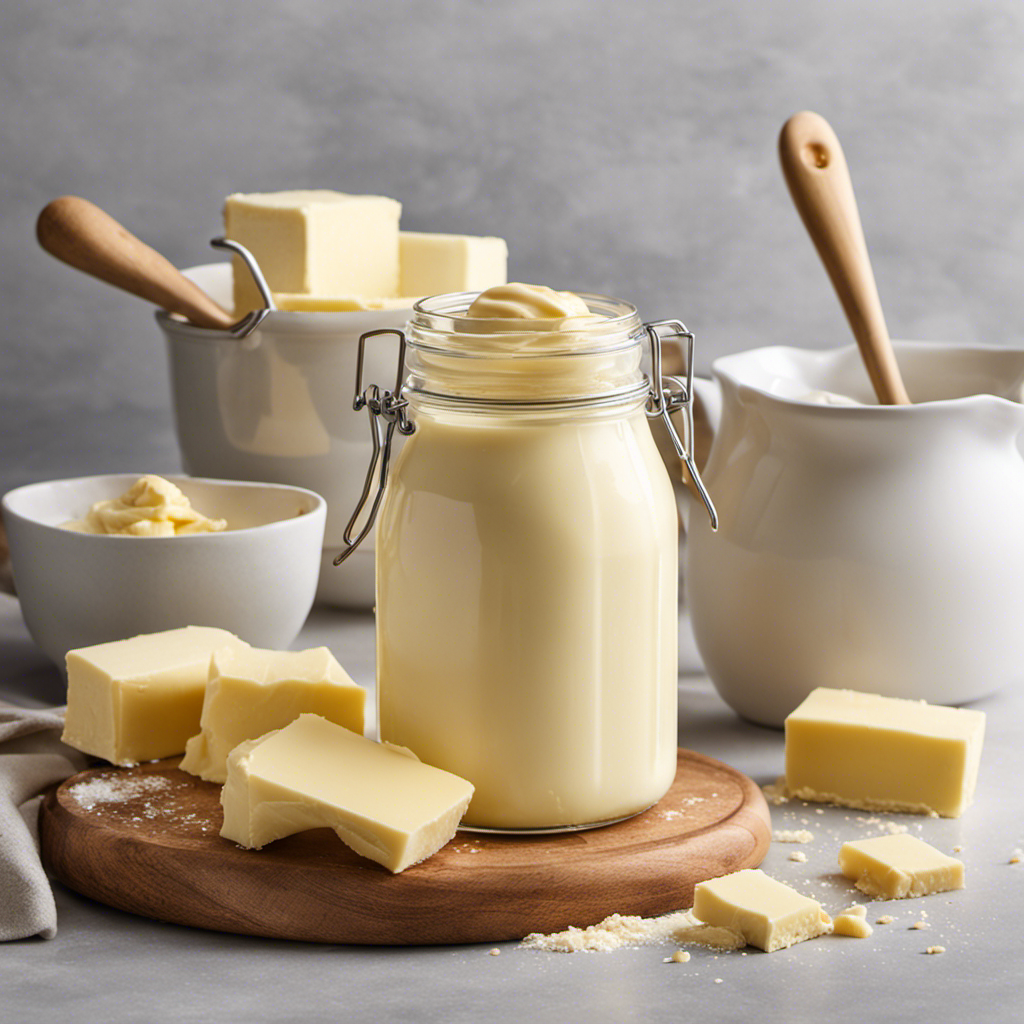I am here to demonstrate how to create the most luxurious shaving butter you have ever tried.
Picture this: you, gliding a razor effortlessly across your skin, feeling the luxurious moisture and protection from your homemade creation.
In just a few simple steps, I’ll guide you through choosing the right ingredients, creating the perfect blend, and even adding a touch of fragrance with essential oils.
Say goodbye to traditional shaving cream and join me on this journey to crafting your very own shave butter.
Key Takeaways
- Shave butter provides superior moisturizing properties and reduces the risk of irritation and razor burn.
- The key ingredients in shave butter, such as shea butter, coconut oil, and aloe vera gel, nourish, soothe, and protect the skin.
- Essential oils can be added to shave butter for fragrance and additional benefits, such as calming effects and reducing razor burn.
- Shave butter can be customized to suit personal preferences by adjusting the scent, consistency, and adding exfoliating ingredients for a smoother shave.
Benefits of Shave Butter
You’ll love the benefits of using shave butter for a smoother and more comfortable shave. Shave butter is a versatile and effective product that offers several advantages over traditional shaving creams or gels.
One of the key benefits of shave butter is its superior moisturizing properties. It contains nourishing ingredients such as shea butter, coconut oil, and glycerin, which help to hydrate and soften the skin, reducing the risk of irritation and razor burn.
Additionally, shave butter provides excellent lubrication, allowing the razor to glide smoothly across the skin, resulting in a closer shave and fewer nicks and cuts.
To use shave butter effectively, simply apply a thin layer to damp skin and massage it in before shaving. This will ensure optimal performance and leave your skin feeling silky smooth.
Now, let’s explore the next step in creating the perfect shave butter – choosing the right ingredients.
Choosing the Right Ingredients
When it comes to creating the perfect shave butter, two key factors should be taken into consideration: key ingredient selection and ingredient compatibility.
The selection of high-quality ingredients is essential in order to achieve the desired results, such as moisturizing the skin and providing a smooth, close shave.
Additionally, it is crucial to consider the compatibility of the chosen ingredients to ensure that they work harmoniously together and do not cause any adverse reactions or skin irritations.
Key Ingredient Selection
To make shave butter, start by selecting key ingredients that will provide the necessary moisturizing and nourishing properties. When choosing natural ingredients for your homemade shave butter, it’s important to consider their benefits and how they will contribute to a smooth and comfortable shaving experience.
Here are three essential ingredients to include:
-
Shea Butter: Known for its exceptional moisturizing properties, shea butter helps to hydrate and soothe the skin, reducing irritation and razor burn.
-
Coconut Oil: Rich in fatty acids, coconut oil helps to nourish and protect the skin, leaving it feeling soft and smooth. It also has antimicrobial properties that can help prevent infections.
-
Aloe Vera Gel: Aloe vera gel is well-known for its soothing and cooling properties. It can help to calm any skin irritation and promote healing, making it an excellent addition to shave butter.
Ingredient Compatibility Considerations
Consider the compatibility of the ingredients before mixing them together. Ingredient compatibility is crucial in ensuring the effectiveness and stability of your shave butter. By carefully selecting and combining compatible ingredients, you can create a product that delivers optimal results and has a longer shelf life.
When it comes to ingredient compatibility, it is important to consider factors such as solubility, pH levels, and chemical interactions. Certain ingredients, when combined, can lead to undesirable reactions or even render the product ineffective. To help you understand the compatibility of common shave butter ingredients, I have created a table below:
| Compatible Ingredients | Incompatible Ingredients |
|---|---|
| Shea butter | Alcohol |
| Coconut oil | Fragrance oils |
| Aloe vera | Citrus essential oils |
Step-by-Step Shave Butter Recipe
First, let’s gather all the ingredients needed for the step-by-step shave butter recipe. To reap the benefits of shave butter and perfect your shaving techniques, you’ll need the following:
-
Shea Butter: This natural moisturizer helps soften the skin, making it easier for the razor to glide smoothly without causing irritation or razor burns.
-
Coconut Oil: Its antibacterial properties protect the skin from infections while providing deep hydration, leaving your skin feeling nourished and smooth.
-
Castor Oil: This thick oil helps create a protective barrier, reducing friction during shaving and preventing ingrown hairs.
By combining these ingredients, you’ll create a luxurious shave butter that not only enhances your shaving experience but also leaves your skin feeling moisturized and refreshed.
Now, let’s move on to the next section and explore the use of essential oils for added fragrance.
Essential Oils for Added Fragrance
Now, let’s take a look at how you can enhance the fragrance of your shave butter by adding essential oils.
When it comes to fragrance choices, the possibilities are endless. However, it’s important to choose essential oils that not only smell great but also provide additional benefits for your skin. Lavender, for example, has a calming effect and can soothe irritated skin. Peppermint, on the other hand, gives a refreshing sensation and can help reduce razor burn.
When adding essential oils to your shave butter, it’s crucial to follow dilution guidelines to ensure safety and effectiveness. Generally, a safe dilution ratio is 2-3% for adults. This means adding about 10-15 drops of essential oil per ounce of shave butter.
Tips for Customizing Your Shave Butter
When it comes to customizing your shave butter, there are several key points to consider.
First, scent options can be tailored to suit your personal preferences, allowing you to create a fragrance that is uniquely yours.
Additionally, adding exfoliating ingredients can enhance the performance of your shave butter, helping to remove dead skin cells and promote a smoother shave.
Lastly, adjusting the consistency of your shave butter allows you to achieve the texture that best suits your preference, whether it be a thick and creamy consistency or a lighter, more airy feel.
Scent Options for Customization
You can choose from various scent options to customize your shave butter. When it comes to packaging options, there are a few popular choices that can enhance your shaving experience.
Here are three scent combinations that are highly sought after:
-
Citrus Burst: This invigorating blend combines notes of orange, lemon, and grapefruit to awaken your senses and provide a refreshing start to your day. The zesty aroma will leave you feeling energized and ready to tackle anything that comes your way.
-
Woodsy Spice: If you prefer a more earthy and masculine scent, this combination is perfect for you. With hints of sandalwood, cedarwood, and black pepper, it creates a warm and comforting atmosphere during your shaving routine.
-
Fresh and Clean: For a crisp and clean scent, opt for a combination of lavender, mint, and eucalyptus. This blend offers a soothing and calming effect, leaving your skin feeling refreshed and revitalized.
Adding Exfoliating Ingredients
To enhance your shaving routine, consider incorporating exfoliating ingredients into your chosen scent combination for a refreshed and rejuvenated experience.
Exfoliating benefits are well-known in skincare, and they can also work wonders for your shaving routine. By including natural exfoliants in your shave butter, you can effectively remove dead skin cells and unclog pores, resulting in a closer, smoother shave.
Natural exfoliants like ground coffee, sugar, or oatmeal can gently slough off dead skin, while also providing additional benefits such as reducing ingrown hairs and promoting skin cell regeneration. These ingredients can be easily mixed into your shave butter recipe to create a luxurious and invigorating texture.
By adding exfoliating ingredients, you can elevate your shaving experience to new heights of smoothness and freshness.
Now, let’s explore the next step: adjusting consistency for preference.
Adjusting Consistency for Preference
If you prefer a thicker texture, you can add more of the main ingredient to your mixture. Adjusting the consistency of your shave butter is crucial to achieving the desired smoothness.
Here are three ways you can do this:
-
Increase the amount of shea butter: Shea butter is the main ingredient in shave butter and provides moisturizing properties. Adding more shea butter will result in a thicker and creamier consistency.
-
Use less liquid oil: Liquid oils, such as coconut oil or jojoba oil, can make the shave butter more runny. By reducing the amount of liquid oil in your mixture, you can create a denser texture.
-
Whip the ingredients longer: The whipping process aerates the mixture and gives it a lighter and fluffier texture. Increase the whipping time to achieve a smoother consistency.
How to Store Shave Butter Properly
When storing shave butter properly, remember to keep it in a cool, dry place to maintain its consistency. Proper storage is essential in prolonging the shelf life of shave butter and ensuring its optimal performance.
The ideal temperature range for storage is between 50-70°F (10-21°C). Exposing shave butter to extreme heat or cold can cause it to melt or harden, respectively, compromising its texture and effectiveness.
Additionally, it is crucial to store shave butter in an airtight container to prevent moisture and air exposure, which can lead to spoilage and the growth of bacteria. Avoid placing shave butter near direct sunlight or in humid environments, as these conditions can degrade its quality over time.
Shave Butter Vs. Traditional Shaving Cream
When it comes to shaving, the choice between shave butter and traditional shaving cream can make a big difference. As an experienced shaver, I have found that shave butter offers several benefits over its cream counterpart.
First and foremost, shave butter provides superior moisturization. Its rich and creamy texture contains natural oils and butters that deeply hydrate the skin, leaving it smooth and supple. This helps to prevent irritation and razor burn, which can be common with traditional shaving creams.
Secondly, shave butter offers enhanced lubrication. Its unique formula creates a slick barrier between the razor and the skin, allowing for a smoother glide and reducing the risk of nicks and cuts.
Lastly, shave butter is often made with natural ingredients. These can include nourishing oils like coconut or shea butter, which provide additional benefits for the skin.
Common Mistakes to Avoid When Making Shave Butter
To avoid common mistakes when creating your own shave butter, be sure to thoroughly blend all of the ingredients together until they form a smooth and creamy consistency. Achieving a smooth shave is not only about the right technique but also about using the right products. Making your own shave butter can be a cost-effective and customizable option, but it is important to avoid some common pitfalls. One common mistake is not blending the ingredients enough, resulting in a grainy texture that can irritate the skin. Another mistake is using the wrong type or amount of oils, which can make the shave butter too greasy or not moisturizing enough. Additionally, not properly measuring the ingredients can throw off the balance and affect the overall performance of the shave butter. By following these tips and avoiding these common mistakes, you can create a shave butter that will provide a smooth and comfortable shaving experience.
| Common Mistakes to Avoid | Tips for Achieving a Smooth Shave |
|---|---|
| Not blending enough | Thoroughly blend ingredients |
| Using wrong oils | Choose oils suitable for shaving |
| Improper measurements | Accurately measure ingredients |
| ————————- | ———————————- |
Frequently Asked Questions About Shave Butter
After discussing the common mistakes to avoid when making shave butter, let’s address some frequently asked questions about this popular grooming product.
There are a few common misconceptions surrounding shave butter that I would like to clear up.
-
Misconception: Shave butter is only suitable for men.
- Fact: Shave butter can be used by both men and women for a smooth and comfortable shaving experience.
-
Misconception: Shave butter is difficult to apply.
- Fact: Applying shave butter is simple. Just rub a small amount onto damp skin and let it soften the hair for an effortless shave.
-
Misconception: Shave butter can cause irritation.
- Fact: With the right technique, shave butter can actually reduce irritation. Use a sharp razor, apply gentle pressure, and shave in the direction of hair growth.
Frequently Asked Questions
Can I Use Shave Butter on Other Parts of My Body Besides My Face?
Yes, you can use shave butter on other parts of your body besides your face. Shave butter benefits include moisturizing and protecting the skin. It can be used as an alternative to shaving cream or as a moisturizer for dry areas.
Will Shave Butter Clog My Razor?
No, shave butter will not clog your razor. However, proper storage is crucial to maintaining its texture. Store shave butter in a cool, dry place to prevent it from melting or becoming too hard. Additionally, you can also explore alternative uses for shave butter, such as moisturizing dry skin or conditioning your beard.
Is Shave Butter Suitable for All Skin Types?
Shave butter can work for different skin types, but it’s important to choose the right one. Pros include a smooth shave and moisturized skin, but cons include potential irritation and clogged pores.
Can I Use Shave Butter if I Have Sensitive Skin?
Having sensitive skin, I understand the importance of choosing the right shave butter. Using shave butter for sensitive skin requires selecting a product with soothing ingredients like aloe vera and chamomile.
Can Shave Butter Be Used by Both Men and Women?
Shave butter can benefit both men and women. It offers a smooth and moisturizing shave, reducing irritation and razor burn. Men can use it to groom facial hair, while women can use it for a closer shave on legs and underarms.
Conclusion
In conclusion, creating your own shave butter can be a game-changer in your shaving routine. By carefully selecting the right ingredients and following the step-by-step recipe, you can achieve a smooth and luxurious shave experience.
Don’t forget to add some essential oils for that extra touch of fragrance. Customizing your shave butter allows you to tailor it to your preferences, ensuring a personalized grooming experience.
Remember to store your shave butter properly to maintain its quality. Embrace the superiority of shave butter over traditional shaving cream and avoid common mistakes for optimal results.
And if you still have questions, refer to the frequently asked questions section for clarification. Happy shaving!
